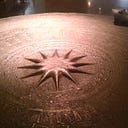Java on the Catalan Atlas (1375)
This piece appeared on my Patreon account way back in 2022. I thought I’d move it here so that it would be more accessible.
THE CATALAN ATLAS is the name given to a series of maps made by the Jewish cartographer Elisha ben Abraham Cresques in Mallorca in around 1375, bound together in a single codex now kept in the Bibliothèque nationale de France in Paris (shelfmark: Espagnol 30). This Atlas amounts to a world map in several folios, although naturally it only includes Africa, Asia, and Europe.
The depiction of Europe, North Africa, and the Mediterranean on the Atlas is reasonably accurate, but as on many medieval European maps the depiction of the Indian Ocean and lands to the east is a little skewed. For these places European cartographers tended to rely on information brought back by people like Marco Polo, Odoric of Pordenone, and Jordanus the Catalan; in the absence of detailed geographical surveys this information was interpreted in different ways by different cartographers. Each medieval European map, therefore, has its own way of portraying further Africa and Asia.
What’s interesting about the Catalan Atlas is that it contains a very early representation of the island of Java — perhaps the oldest surviving such representation in European cartography. The depiction isn’t particularly accurate: it shows the island as located close to the coast of India instead of four thousand kilometres to its southeast and, as so often with western Afro-Eurasian writings on ‘Java’, it’s not clear whether this ‘Java’ is supposed to be Java or Sumatra or both.
The depiction on the Catalan Atlas — which is named, incidentally, for the fact that its captions and introduction are in Catalan — seems to fuse Marco Polo’s descriptions of the two islands, the ‘smaller’ Java (i.e. Sumatra) and the ‘bigger’ Java (i.e. Java). The name used for this island is IANA, appearing in large Lombardic capitals in the middle of the landmass, below an image of a queen bearing a golden orb and a sword (Figure 1):
ILLA IANA
‘island of Iana’
It is sometimes claimed that this Illa Iana is unidentified. As I’ve mentioned before, though, the ⟨n⟩ here is the result of a common copying error. Marco Polo and Odoric of Pordenone both knew Java as ⟨Jaua⟩ — but ⟨u⟩ and ⟨n⟩ look very similar in the scripts used in much of Europe in the fourteenth century and mix-ups were common, especially with unfamiliar names like this. ⟨Jana⟩ was thus the standard name for Java/Sumatra in Europe before the sixteenth century, or at least before the return of Niccolò de’ Conti from Egypt in 1444. (Conti knew Java as Giava or Jaua.)
Illa Iana has four towns on it — or so it seems from the depiction on the map (at top). These towns or castles are named (from top-right to bottom-left when oriented with the words Illa Iana the right way up):
recn͠o femarum
malao
auzul
semescra
The first means ‘kingdom of women’, and may be related to other accounts of kingdoms inhabited exclusively by men and women respectively in various medieval travel accounts, including Polo’s. Arabic accounts tended to say that a kingdom of women could be found in the Baltic Sea; European ones tended to locate such kingdoms in the Indian Ocean. This may explain the presence of the prominent image of a queen, sword and orb in hand, on the depiction of the island. This queen probably shouldn’t be identified with any specific Javanese queens. (I’ve seen Indonesian historians equate the queen here with Sri Tribhuwana, but I don’t think there’s any evidence to support this.)
Malao might be from Polo’s Malaiur, the name of a kingdom in Sumatra; Semescra might be related to Polo’s Samatra or Samara — they’re so distorted that it’s hard to be sure. Auzul is unrecognisable.
Arranged along the side of this Illa Iana is a caption describing the island’s produce (Figure 2):
En la illa íana ha molts arbres lía͠yloes / camphora sandels
specíes subtíls / garenga / nou moscada / arbres [de canyela / la-]
qual es pus precíosa de qual se uol altra de tota la índía ɀ so[n]
axi mateíx aquj maçís / ɀ folíj :-
‘On the island of Iana there are many trees — lignaloes, camphor, and sandal; subtle spices, galangal, nutmeg, trees of cinnamon, which is more precious than those in all of India. Mace and leaves [?] are themselves also found there.’
This caption appears to come from Polo’s account of the ‘bigger island’ of Java — i.e. Java — albeit with a rather different list of spices to that found in the earliest manuscripts. In fact, only one of these spices, galangal (Alpinia galanga, Javanese: laos), reliably grew on the island of Java in the fourteenth century, though the others could doubtless be acquired there. ‘Lignaloes’ is the usual name for aloeswood or agarwood in European texts of this period; aloeswood is a kind of pricey incense from Southeast Asia made from the wood of trees in the genus Aquilaria. In Malay it’s called gaharu and in Old Javanese agaru (from the Middle Indo-Aryan name).
In any case: this is perhaps the oldest appearance of an island with a ‘Java’-name on a surviving European map (with the notable exception of the Greek maps made on the basis of descriptions of Asia in Ptolemy’s Geographia, the oldest surviving copies of which date to a few decades prior to the completion of the Catalan Atlas). It is, as you can see, a bit of a mess. It combines accounts of at least two islands with a dose of folklore, and as a source on the history of Java it isn’t much use. It is nonetheless interesting that the name of the island was known so far outside of it at this time.
A. J. West — Leiden, 2022 (posted here 2024).
